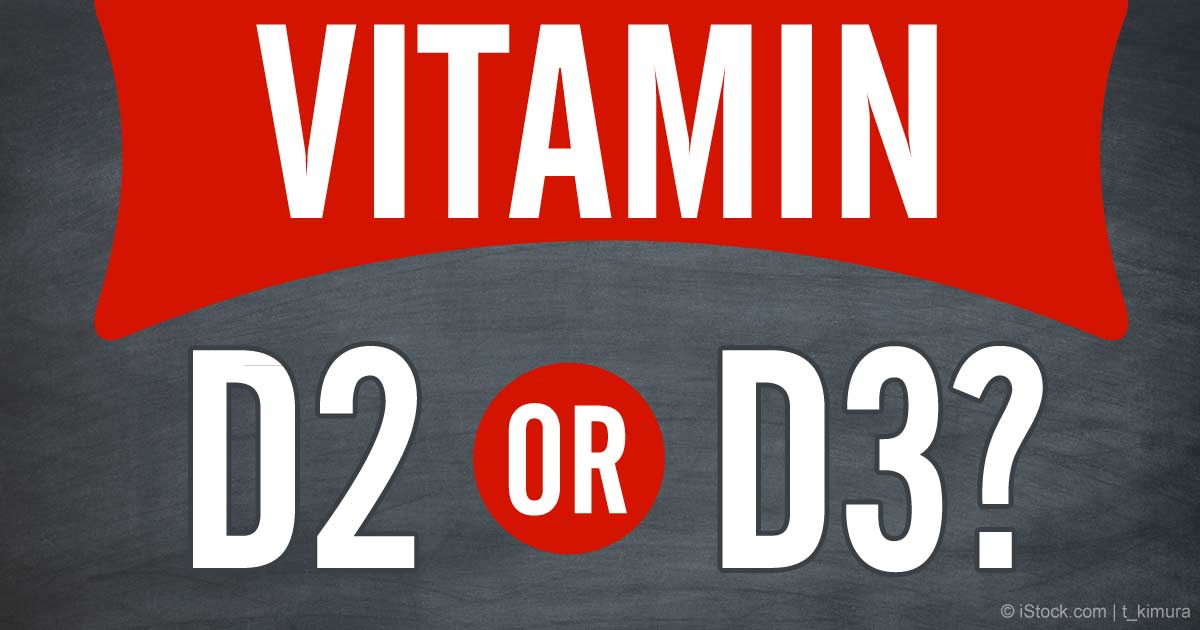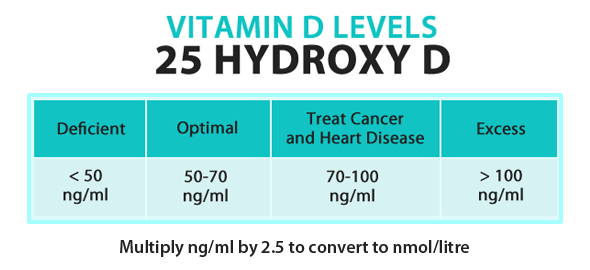
By Dr. Mercola
Did you know there are two types of vitamin D, and they are NOT interchangeable?
In fact, taking the wrong one could do you more harm than good...
Drisdol is a synthetic form of vitamin D2—made by irradiating fungus and plant matter—and is the form of vitamin D typically prescribed by doctors.
This is not the type produced by your body in response to sun or safe tanning bed exposure, which is vitamin D3.
A recent meta-analysis by the Cochrane Databasei looked at mortality rates for people who supplemented their diets with D2 versus those who did so with D3, the form naturally produced by your body, highlighting the significant differences between the two.
The analysis of 50 randomized controlled trials, which included a total of 94,000 participants, showed:
According to the Vitamin D Councilii:
- A six percent relative risk reduction among those who used vitamin D3, but
- A two percent relative risk increase among those who used D2
"You would think a paper that took a look at tens of thousands of subjects and analyzed the efficacy of prescription vitamin D (D2) and over-the-counter vitamin D (D3) would warrant a news story or two.
To my knowledge, these papers are the first to paint such a clear picture about the efficacy between D3 and D2.
While there may be explanations for D3's superiority other than improved efficacy, for the time being, these papers send doctors a message: use D3, not D2."
The Difference Between Supplemental Vitamin D2 and D3
The notion that vitamin D2 and D3 were equivalent was based on decades-old studies of rickets prevention in infants. Today, we know a lot more about vitamin D, and the featured study offers compelling support for the recommendation to take vitamin D3 if you need to take an oral supplement—which is the same type of D vitamin created in your body when you expose your skin to sunlight.
Supplemental vitamin D comes in two forms:
I personally recommend getting your vitamin D from safe sun exposure (or a safe tanning bed), as there's compelling reason to believe the vitamin D created in your skin in response to sun exposure has some slight but important differences that make it even more beneficial than supplemental vitamin D3. I will address this more in just a moment, but first, let's review the differences between the two types of supplemental vitamin D. Aside from the featured findings that supplemental vitamin D3 reduced the relative mortality risk by six percent, while D2 actually INCREASED mortality risk by two percent, the two types differ in the following ways:
- Ergocalciferol (vitamin D2)
- Cholecalciferol (vitamin D3)
- According to the latest research, D3 is approximately 87 percent more potentiii in raising and maintaining vitamin D concentrations and produces 2- to 3-fold greater storage of vitamin D than does D2.
- Regardless of which form you use, your body must convert it into a more active form, and vitamin D3 is converted 500 percent faster than vitamin D2.
- Vitamin D2 also has a shorter shelf life, and its metabolites bind poorly with proteins, further hampering its effectiveness.
What about Dietary Sources? Animal-Based versus Plant-Based Vitamin D
Aside from taking an oral vitamin D supplement, you can also obtain small amounts of vitamin D from your diet. Here too, it's important to realize that not all food sources provide the same kind of vitamin D. Plant sources provide you with D2. The more beneficial D3 can only be had through animal-based sources such as:
Dairy processors producing pasteurized milk have also been fortifying milk with vitamin D since 1933. Today, about 98 percent of the milk supply in the U.S. is fortified with approximately 400 International Units (IU) of vitamin D per quart. While dairies used to fortify their milk with vitamin D2, most have now switched over to D3. But, if you still drink pasteurized milk (which I don't recommend), check the label to see which form of vitamin D has been added. (If you drink raw milk, then you're getting the naturally-occurring vitamin D in the milk fat.) Keep in mind that although milk is fortified, other dairy products such as cheese and ice cream does typically not contain added vitamin D.
- Fish, such as salmon, mackerel, tuna and sardines
- Egg yolk
- Raw milk
Vitamin D Can Make or Break Your Health, So Get the Right Kind!
There's overwhelming evidence that vitamin D is a key player in your overall health. This is understandable when you consider that it is not "just" a vitamin; it's actually a neuroregulatory steroidal hormone that influences nearly 3,000 different genes in your body. Receptors that respond to the vitamin have been found in almost every type of human cell, from your brain to your bones.
Just one example of an important gene that vitamin D up-regulates is your ability to fight infections, as well as chronic inflammation. It produces over 200 antimicrobial peptides, the most important of which is cathelicidin, a naturally occurring broad-spectrum antibiotic. This is one of the explanations for why it can be so effective against colds and influenza.
Optimizing your vitamin D levels should be at the top of the list for virtually everyone, regardless of your age, sex, color, or health status, as vitamin D deficiency has been linked to an astonishingly diverse array of common chronic diseases, such as:
| Cancer | Hypertension | Heart disease |
| Autism | Obesity | Rheumatoid arthritis |
| Diabetes 1 and 2 | Multiple Sclerosis | Crohn's disease |
| Cold & Flu | Inflammatory Bowel Disease | Tuberculosis |
| Septicemia | Signs of aging | Dementia |
| Eczema & Psoriasis | Insomnia | Hearing loss |
| Muscle pain | Cavities | Periodontal disease |
| Osteoporosis | Macular degeneration | Reduced C-section risk |
| Pre eclampsia | Seizures | Infertility |
| Asthma | Cystic fibrosis | Migraines |
| Depression | Alzheimer's disease | Schizophrenia |
The IDEAL Way to Optimize Your Vitamin D Levels
While this article is focused on the two types of oral vitamin D supplementation, it's important to realize that the IDEAL way to optimize your vitamin D levels is through appropriate sun or safe tanning bed exposure. While your skin does create vitamin D3 in response to sun light, which is theoretically the same as the D3 you get from an oral supplement, there's cause to believe that the vitamin D created from sun exposure may have additional health benefits, and here's why:
So essentially, getting regular sun exposure has much greater health ramifications than "just" raising your vitamin D levels and preventing infections. Sun exposure also appears to play a role in heart and cardiovascular health, and much more!
- When you expose your skin to the sun, your skin also synthesizes high amounts of cholesterol sulfate, which is very important for heart and cardiovascular health. In fact, according to research by Dr. Stephanie Seneff, high LDL and subsequent heart disease may in fact be a symptom of cholesterol sulfate deficiency. Sulfur deficiency also promotes obesity and related health problems like diabetes
- When exposed to sunshine, your skin also synthesizes vitamin D3 sulfate. This form of vitamin D is water soluble, unlike oral vitamin D3 supplements, which is unsulfated. The water-soluble form can travel freely in your bloodstream, whereas the unsulfated form needs LDL (the so-called "bad" cholesterol) as a vehicle of transport. According to Dr. Stephanie Seneff, there's reason to believe that many of the profound benefits of vitamin D are actually due to the vitamin D sulfate. As a result, she suspects that the oral non-sulfated form of vitamin D might not provide all of the same benefits, because it cannot be converted to vitamin D sulfate
- You cannot overdose when getting your vitamin D from sun exposure, as your body has the ability to self-regulate and only make what it needs
If you cannot get your vitamin D requirements from sun exposure, I recommend using a safe tanning bed (one with electronic ballasts rather than magnetic ballasts, to avoid unnecessary exposure to EMF fields). Safe tanning beds also have less of the dangerous UVA than sunlight, while unsafe ones have more UVA than sunlight. If neither of these are feasible options, then you should take an oral vitamin D3 supplement. It will certainly be better than no vitamin D at all.
How Much Vitamin D Should You Take?
Some 40 leading vitamin D experts from around the world currently agree that there's no specific dosage level at which "magic" happens; rather the most important factor when it comes to vitamin D is your serum level (the level of vitamin D in your blood). So you really should be taking whatever dosage required to obtain a therapeutic level of vitamin D in your blood.
That said, based on the most recent research by GrassrootsHealth—an organization that has greatly contributed to the current knowledge on vitamin D through their D* Action Study—it appears as though most adults need about 8,000 IU's of vitamin D a day in order to raise their serum levels above 40 ng/ml.4 For children, many experts agree they need about 35 IU's of vitamin D per pound of body weight.
At the time GrassrootsHealth performed the studies that resulted in this dosage recommendation, the optimal serum level was believed to be between 40 to 60 ng/ml. Since then, the optimal vitamin D level has been raised to 50-70 ng/ml, and when treating cancer or heart disease, as high as 70-100 ng/ml, as illustrated in the chart above.
What this means is that even if you do not regularly monitor your vitamin D levels (which you should), your risk of overdosing is going to be fairly slim even if you take as much as 8,000 IU's a day. However, the only way to determine your optimal dose is to get your blood tested regularly, and adjust your dosage to maintain that goldilocks' zone.
For more information, including an in-depth explanation of everything you need to know before you get tested, please see Test Values and Treatment for Vitamin D Deficiency.

No comments:
Post a Comment